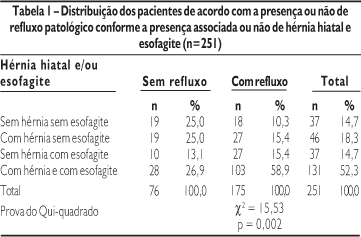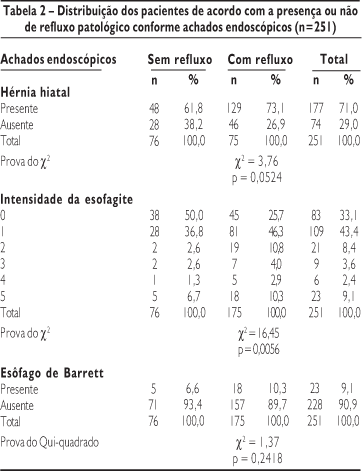OBJECTIVE: To analyze clinical, abdominal ultrasound, upper digestive endoscopic, esophageal manometric and prolonged esophageal pH-monitoring findings in patients with typical symptoms of GERD. METHODS: The study included a total of 251 patients with typical GERD symptoms. Clinical data, Body Mass Index, abdominal ultrasound aspects and upper digestive endoscopic data are reported. Manometry and esophageal pH-monitoring were performed. RESULTS: One-hundred-and-seventy-two patients were female (68.5%). Mean age of the total was 51.8 years. Ultrasound examination revealed colelithiasis in 23 patients and PC in 21 patients. Hiatal hernia was diagnosed in 177 patients (71%), with an average size of 3.0cm. Erosive esophagitis was found in 168 patients (66.9%) and Barrett's esophagus in 23 patients (9.2%). A combination of hiatal hernia and esophagitis was diagnosed in 131 patients (52.3%) while only 37 patients (14.7%) did not present either. The mean extension of the lower esophageal sphincter (LES) was 2.6 cm, whereas in 132 patients (52.6%) the LES was shorter. The mean pressure of the LES was 18.9 mmHg; 46 patients (18.3%) had pressures below 14 mmHg. The mean number of reflux episodes on prolonged esophageal monitoring was 42.9; the mean number of prolonged episodes of reflux was 4.6, and the mean percentage of total acid time was 8.4%. DeMeester scores were high in 175 patients (69.7%). CONCLUSION: In patients with typical GERD symptoms, factors influencing the presence of pathological reflux as confirmed by prolonged esophageal pH-monitoring were: age, hiatal hernia associated to erosive esophagitis, a smaller extension, low baseline pressure and smaller volume vector of the LES.
Gastroesophageal reflux; Esophagitis; Hiatal hernia


